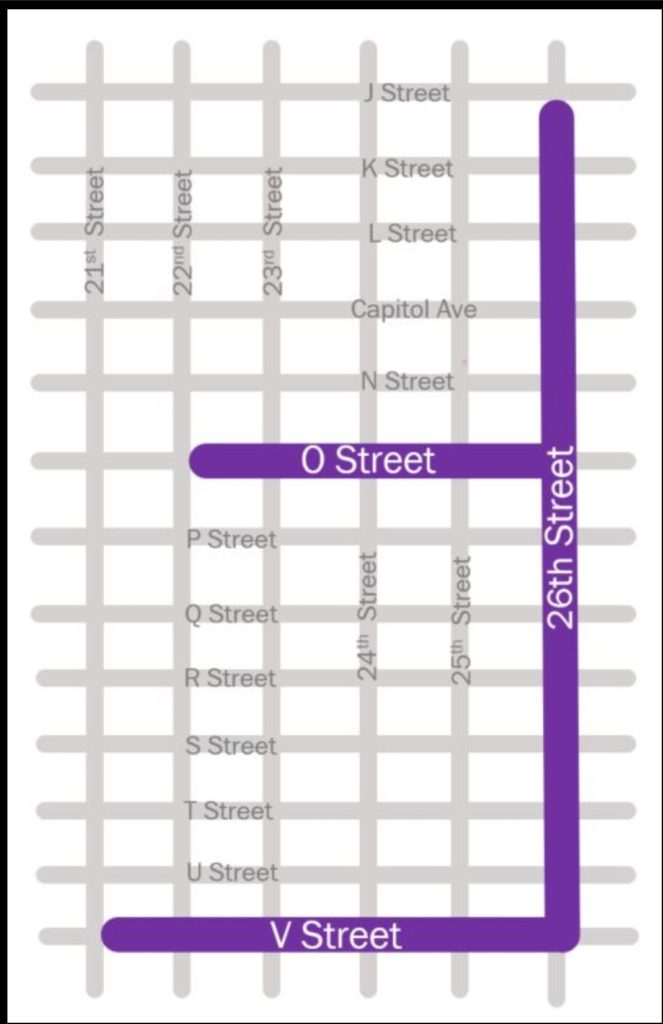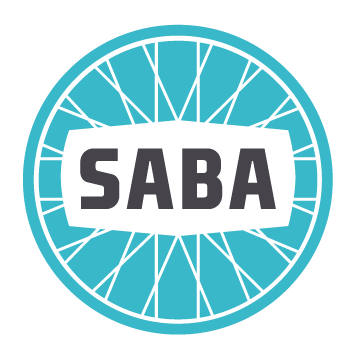
Update: October 15, 2021
The Slow and Active Streets Pilot has come to a close in Sacramento and the City's Public Works Dept. has put out a report about the effort. Read the entire report here.
Here are our takeaways:
- Of the 1200 respondents to a survey put out by the City (with assistance from us at SABA), 60% of them were positive about the pilot. 26% were negative and another 14% were neutral. This is good news. Almost 3:1 people were in favor of seeing their streets used for something other than speeding vehicles.
- Slowed streets were calmer: 27% of respondents reported driving LESS on the Slow and Active Streets.
- Even though the City was slow in getting this pilot up and running (City Council gave the green light in December 2020, but the first neighborhood didn't get started until mid February, and the entire pilot was over by the end of July), 30% of survey respondents reported an increase in walking, riding, running and scooting, then before the pilot.
- We heard from a number of people who thought the scarce resources allocated to the Pilot could've been used in a different fashion, but the respondents still wanted those dollars to go to making streets safer for all users. Good news in that their focus is in the right place - safe streets!
- The total amount of dollars to run the pilot was $241,000. This is a low number, if you add in the hours spent by a number of organizations like ours, who helped to advocate for, facilitate, and activate the neighborhoods who were "Slowed".
- The upshot was a higher rate of engagement for the Pilot. This is also good news, because it tells us that people do care about their neighborhood, and how their streets are used or abused.
- In the final analysis, people want two things: Slowed traffic and comfortable places to walk, bike and scoot.
So then, what's next for Slow and Active Streets?
Let's start with the City. Although they are pushing for carbon neutrality by 2030, and they know that transportation is one of the highest emitters of pollutants into our air, they have been slow to prioritize bike and pedestrian travel at the top of the modal hierarchy. Funding should be proportionally allocated to make possible the mode shift targets. The promotion of cycling is not an end in itself; rather, it is a means of creating a safer, more comfortable and more functional urban environment. The more people travel on foot, by bicycle and by public transit, and leave their car behind, the greater the number of people who can efficiently move about the city.
The Mayors’ Commission on Climate Change identified a set of priorities with active transportation at the top of the hierarchy. The report states, “To achieve a significant shift away from vehicle use, the cities will need to create an environment that enables greater use of active transportation modes by making travel by walking and rolling more accessible, safe and convenient. This strategy is focused on making active transportation a viable and attractive option by increasing the connectivity of active transportation corridors to create a seamless network, as well as by providing basic amenities at the neighborhood level so that shorter trips can be taken by walking or rolling to meet daily needs.”
Sacramento can and should do more.
Perhaps the only silver lining of the pandemic was that it gave us a chance to re-visit and re-think how our roads serve us. Cities worldwide are making significant strides in changing their roadways and transportation systems. The pandemic gave rise to the idea of the “15-minute City”, which is built on the premise of a street network that is walkable and ridable where one can access parks, food, medicine, schools and businesses within 15 minutes. Research tells us that beyond density, a walkable and ridable urban fabric is necessary to make the 15-minute city work. That implies a connected network of thoroughfares (streets, passages, trails) and small blocks knitting together the neighborhoods.
Sacramento has some of this in place, but it is missing a low stress network of routes to get in and out of town and within and around town. Low-stress routes are routes that are safe and comfortable for people of all ages and abilities to ride a bike. Neighborhood streets are typically low stress because they have low speed limits (25 mph or less), two or fewer motor vehicle travel lanes and low volume car traffic. Busier streets can also be low stress for bikes if they have adequate infrastructure that helps separate bikes from cars, like protected bike lanes. Low-stress intersections provide safe ways for people on bikes to cross busy streets through intersection treatments like traffic signals, flashing lights and crossing islands.
In the Statehouse: A.B. 773, from Adrin Nazarian (D-Los Angeles) will make Slow Streets a permanent possibility in state law. This is wonderful as it provides an opportunity for transportation departments and organizations like us continue to find ways to show people how their streets could be used to move people not cars.
We'll be working on a few initiatives in support of the concept of Slow and Active Streets. We want to support and advocate for slowing traffic for residents, and ways to make their street spaces more enjoyable. A low stress connected bicycle network which makes it possible for people to get anywhere around the City by bicycle remains a priority for us.

February 2021: We are pleased to announce that on February 12th, the first set of Slow and Active Streets were launched in Sacramento in the Newton Booth/Midtown neighborhood of town. Congratulations to Abby Jackson and the residents of Newton Booth and Midtown for spearheading this effort. Kudus to city transportation leaders for helping to make this a reality.

in Midtown Sacramento
Read more about the progress made and the work still to be done here.
May, 2020
During these unprecedented times, people need safe places to get outside and exercise. Unfortunately, the surge in people seeking outside space close-to-home is putting a considerable strain on our public spaces. Trails, sidewalks, and parks are overcrowded, making it difficult for people to safely maintain 6 feet of distance between themselves and others.
With dramatically-reduced car traffic due to the pandemic, we have an opportunity to create more public spaces for people to safely get out—by opening up our streets for walking, biking, and physical activity. Closing off selected streets to cars or converting some traffic lanes for biking and walking use can expand access to the outdoors, which is essential to maintaining physical and mental health.
SABA and WalkSacramento have teamed up to urge the City of Sacramento to consider fully or partially closing streets for residents to be able to safely exercise and access essential grocery stores, restaurants, and parks. We know that opening streets for exercise and active transportation is an attainable tactic to improve quality of life and promote public health during this unprecedented public health crisis. Let's join the 30+ cities worldwide in making these changes for Sacramento.
Here's what you can do to help:
Go to this website and SIGN the petition, LEARN more about this effort and let your VOICE be heard in City Hall by sending a letter to your City Council member. Listen here for our take in an interview with Randol White on Capital Public Radio.
Wednesday night, the Sacramento City Council met for a transportation workshop to dive into the myriad of transit issues facing the Sacramento region. Presentations were made by representatives from SACOG, the Public Works department, the Mayor’s Commission on Climate Change and a couple of advocacy groups: SMaRT (a regional transit advocacy group) and SacMoves (a coalition of non-profit organizations including SABA). The hope was to outline the challenges and make a first attempt at prioritization for a potential transportation funding tax measure that the STA Board hopes to get on the ballot in 2020.
There was a lot of discussion about fixing streets that have poor pavement conditions and while working on them, to make our streets, “Complete Streets” for cyclists, peds and alternative modes of transit (scooters and Jump bikes). Safety of our streets also topped the lists of Councilmembers. This is sobering: More people die in Sacramento from traffic fatalities than homicides. While homicides are in a downward trajectory, traffic deaths are on the rise. More than one council member told a recent story of a death as a result of a car vs ped or cyclist. Doubling down on our Vision Zero plan would go a long way to stop fatalities.
The STA Board will be developing a Transportation Expenditure Plan (TEP) and a first draft of this will be released in mid-November. We urge you to learn more about what SABA’s stance is on this by reviewing the SacMoves Vision and Investment Strategy. As we get closer to the STA Board Meeting (which is public), we’ll be asking members to show up and show support for safe streets, clean air, and a multi-modal transit system so that we can always choose to leave our cars at home.






